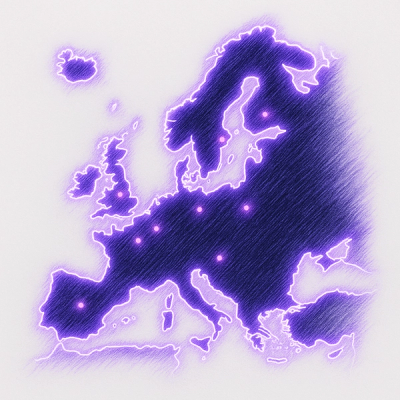FusionMaps is a companion package meant to be used in conjunction with FusionCharts to render data-driven maps (over 2,000+ maps for different continents, countries, states & regions). This package contains choropleth maps that can render on both desktop & mobile, with extended functionality like city or location markers, annotations, events etc.
This package contains definition files for all the maps. Map definition files are the path files required by FusionMaps to plot a map for a particular region. Each map has its own path file.
By default, FusionCharts package only includes definition files for two maps - the World map and the USA map.
Table of Contents
Installing FusionMaps
There are multiple ways to install FusionMaps. For general instructions, refer to this developer docs page.
Direct Download
You can download zipped version here.
Using CDN
Instead of downloading, you can also use FusionCharts’s CDN to access map definition files directly. See below for details
<script src="https://cdn.fusioncharts.com/fusioncharts/latest/maps/<MAP_ALIAS>.js"></script>
MAP_ALIAS is the name of the map that you're plotting, used by FusionMaps. For each map, FusionMaps has a different JavaScript alias. e.g., World Map is world etc.
Install from NPM
npm install --save fusionmaps
You will also need FusionCharts package installed on your system to use maps. You can install the same using below command
npm install --save fusioncharts
See npm documentation to know more about npm usage.
Getting Started
Easiest way to render map is to include the FusionCharts JavaScript library files and map definition file in your webpage, create <div> container and chart instance, configure the data and render. Check this HTML snippet below:
<!doctype html>
<html>
<head>
<script src="https://cdn.fusioncharts.com/fusioncharts/latest/fusioncharts.js"></script>
<script src="https://cdn.fusioncharts.com/fusioncharts/latest/fusioncharts.maps.js"></script>
<script src="https://cdn.fusioncharts.com/fusioncharts/latest/maps/fusioncharts.world.js"></script>
<script src="https://cdn.fusioncharts.com/fusioncharts/latest/themes/fusioncharts.theme.fusion.js"></script>
</head>
<body>
<div id="chart-container"></div>
<script>
FusionCharts.ready(function () {
var chart = new FusionCharts({
type: "world",
renderAt: "chart-container",
width: "600",
height: "400",
dataFormat: "json",
dataSource: {
"chart": {
"caption": "Average Annual Population Growth",
"subcaption": " 1955-2015",
"numbersuffix": "%",
"includevalueinlabels": "1",
"labelsepchar": ": ",
"entityFillHoverColor": "#FFF9C4",
"theme": "fusion"
},
"data": [
{ "id": "NA", "value": ".82", "showLabel": "1" },
{ "id": "SA", "value": "2.04", "showLabel": "1" },
{ "id": "AS", "value": "1.78", "showLabel": "1" },
{ "id": "EU", "value": ".40", "showLabel": "1" },
{ "id": "AF", "value": "2.58", "showLabel": "1" },
{ "id": "AU", "value": "1.30", "showLabel": "1" }
]
}
}).render();
});
</script>
</body>
</html>
As you can see in above example, each continent is referenced using an ID. Each map in FusionMaps has its own regions, each of which have its own ID and name. These are present in specification sheets for the map. You can find specification sheets for all maps here.
Learn more through resources below:
Using FusionMaps as an ES Module
FusionMaps can be loaded as an ES module via transpilers.
The following examples presumes you are using npm to install FusionCharts and FusionMaps, see Installing FusionMaps for more details.
import FusionCharts from 'fusioncharts/core';
import Maps from 'fusioncharts/maps';
import World from fusionmaps/maps/es/world
FusionCharts.addDep(Maps);
FusionCharts.addDep(World);
var chart = new FusionCharts({
type: "world",
renderAt: "chart-container",
width: "600",
height: "400",
dataFormat: "json",
dataSource: {
"chart": {
"caption": "Average Annual Population Growth",
"subcaption": " 1955-2015",
"numbersuffix": "%",
"includevalueinlabels": "1",
"labelsepchar": ": ",
"entityFillHoverColor": "#FFF9C4"
},
"data": [
{ "id": "NA", "value": ".82", "showLabel": "1" },
{ "id": "SA", "value": "2.04", "showLabel": "1" },
{ "id": "AS", "value": "1.78", "showLabel": "1" },
{ "id": "EU", "value": ".40", "showLabel": "1" },
{ "id": "AF", "value": "2.58", "showLabel": "1" },
{ "id": "AU", "value": "1.30", "showLabel": "1" }
]
}
});
chart.render();
Related Packages
Front-end Integrations to help you easily integrate FusionCharts Suite in your projects/apps
Back-end Integrations to help you easily integrate FusionCharts Suite in your projects/apps
Contact Support
Fill this form or drop an email to [support@fusioncharts.com](mailto: support@fusioncharts.com)
Folder Structure
fusionmaps/
└── maps/
├── es
│ ├── fusioncharts.world.js
│ ├── fusioncharts.usa.js
│ ├── ...
│ └── fusioncharts.<MAP_ALIAS>.js
├── fusioncharts.world.js
├── fusioncharts.usa.js
├── ...
└── fusioncharts.<MAP_ALIAS>.js



